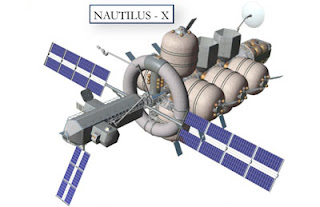Throwing Stuff In Space
In my last post about the Russian space program I said that cosmonauts regularly throw stuff in space so it will burn up and not result in permanent space junk. A reader asks whether you can actually do this.. Man, way to ask a hard question.
Orbital mechanics says "if a space vehicle comes within 120 to 160 km of the Earth's surface, atmospheric drag will bring it down in a few days, with final disintegration occurring at an altitude of about 80 km", and we can work out how much delta-v a cosmonaut has to impart to get the semi-major axis of the orbit of the debris below 160 km.
dVA = sqrt(GM*(2.0/rA - 1.0/((rA + rB) / 2.0))) - sqrt(GM/rA)
where rB = 160km + roE
where rA = 278km + roE to 460km + roE
where roE = 6378.1km
where GM = 6.67300 * 5.9742 * 10^24 * 10^-11
with the ISS at 278km the delta-v retrograde is 34.684365m/s or 77.5867148 mph, which is major league baseball.
with the ISS at 428km the delta-v retrograde is 77.243278m/s or 172.788292 mph, with is space cannon territory.
Ok, let's work out how long it will take to degrade from 250km as a throw to that altitude from the ISS is pretty easy most the time.
We need to know how big the thing we're throwing is, let's say 1m x 1m and 100kg, with a drag coefficient of 2.67.
a = 250km + roE = 6628100
darev = (-2 * pi * Cd * A * p * a^2) / m
darev = (-2 * pi * 2.67 * 1 * 2.62 * 10^-12 * 6628100^2) / 100
darev = -19.3094776
L ~ -H / darev
L ~ -58200 / -19.3094776
L ~ 3014.06393 orbits
P = sqrt(4 * pi^2 * a^3 / GM) = 5369.860522 seconds
L ~ 3014.06393 * 5369.860522 seconds
L ~ 187.32758 days
So the answer is: it's unlikely. It depends how high up the ISS is and how long you're willing to wait for the debris to fall below the 160km altitude. Just letting the part go without a throw will cause it to reenter eventually because no low-Earth orbit is stable, but if you want it to come down in just months you've gotta throw it, and note that you don't throw it "down", you throw it retrograde, and preferably at periapsis, but that's any point on a circular orbit.
Thanks for the question Ian.


I enjoyed the question and response. I liked your answer math. But the question, which also puts me in doubt is: can we play space junk to the Earth? Among the possible physical laws, but in fact just aim for the land and play. But the fact is: can you? I believe in the principles of natural zeal, and even carried by legal principles, can not. In nature nothing is lost, nothing is created, everything changes, as well a great scholar said. What harmful debris thrown to the ground polluting the atmosphere? Only plastic melted and disintegrated? Atomic molecules simple? And the transformation of toxic chemicals, what remains in the atmosphere? I believe there is a good practice. Morally and environmentally negative. The fact is that this is garbage, and it produces its effects. Besides, I believe there is an interesting variant. Take a test: throw a football in the space with a sensor located inside. I believe that depending on the pressure previously calculated and set into the ball, when to launch it from space, it is not disintegrated on hitting the atmosphere. There are reports of having found the integer state of Goias, Brazil, two balls with about five feet in diameter made of carbon fiber braided with two side dishes. It may be the result of atmospheric balloons, but can also be casting two military satellites, since it was not discovered the source. This shows that if the object is soft, it twists, stops and does not burst it hits the ground. You needed to see. Two balls burned carbon fiber, hollow, but light and fluffy. So, I believe we should be more careful with what is thrown to the ground, think of a dispensation to the orbiting space debris and pray for an asteroid does not appear malleable. Incidentally, if space capsules enter the atmosphere and reach the ground is not always signal that the material disintegrates, agree? Finally, I say I am an admirer of mathematics, and congratulate yourself for being devoted to math.
ReplyDeleteFriend Trend.
ReplyDeleteI could be wrong, but fill a ball at sea level, so that when she jump on the floor. Take the space station. Throw the ball from space toward Earth. Is not ala quend burst out from inside the station, because of the lack of pressure, I honestly believe that he could reach the ground. When it reaches the atmosphere it will suffer an impact. If she bear this additional horizontal pressure and not burst, it will begin to fear and can go up, and so up and down, it will reach the ground. Place a small locator in and get tested. It'll be cheaper. Make a leather soccer ball even without fear of being happy! I could be wrong, unfortunately it is. But I believe you can resist. If I am wrong, the ball bursting under the pressure of impact with the atmosphere, or burn if not stop. The point is that I believe the flexibility of a ball has higher braking. What is hard disintegrated on impact, which is soft suits. Take the quiz and find this new law of physics. Impacts between objects, which is harder disintegrates, which is malleable adapts. It's an interesting challenge! :)
You're better off throwing the rubbish backward at apogee rather than at perigee. That way you lower the perigee of the rubbish rather than its apogee, and it's at perigee where most of the drag occurs.
ReplyDelete